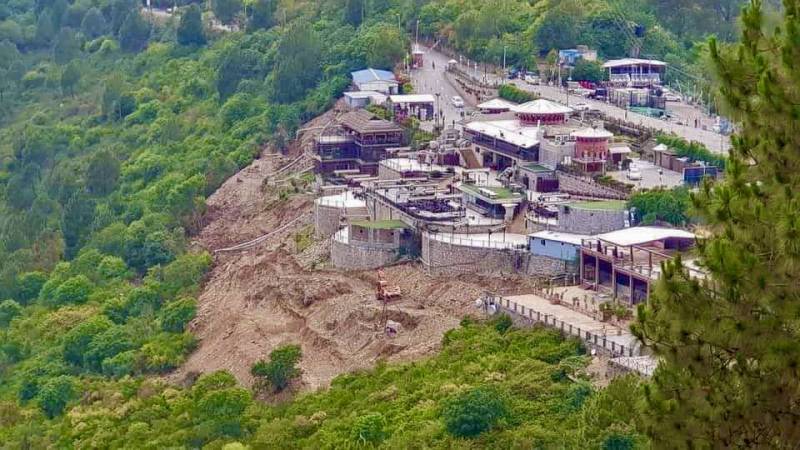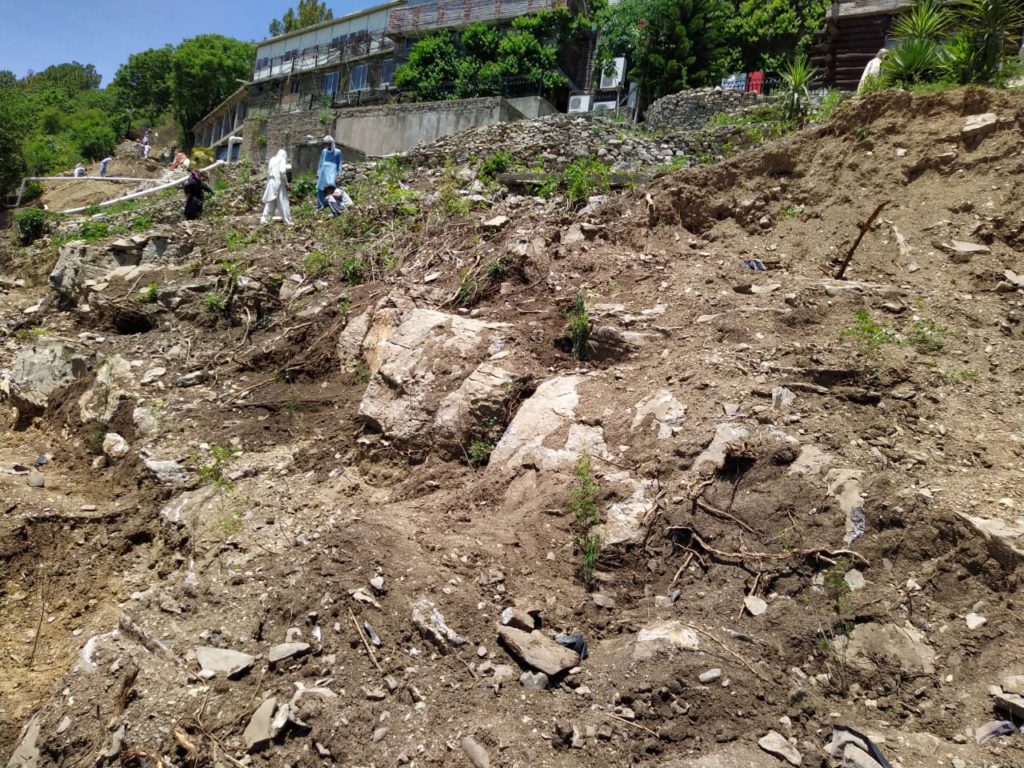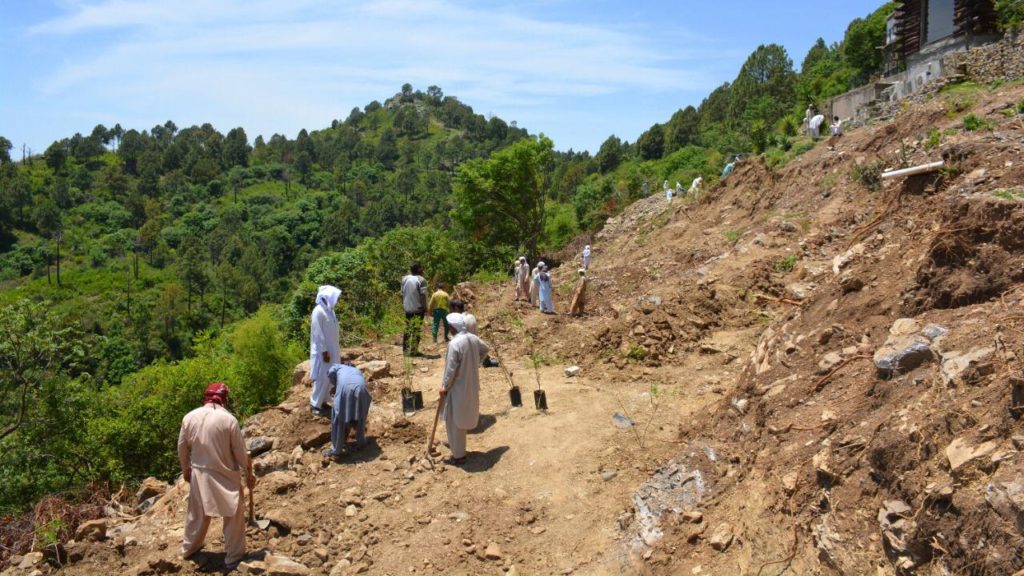
When the Margalla Hills National Park was conceived, its aim was to protect the natural heritage in and around Islamabad. Only a few minutes from the nation’s seat of power ,the Margallas offer a breathtaking view of the twin cities and beyond.
Daman-e-koh, the aptly named recreational area has long been a getaway spot for families, rich and poor and the young and the old. While the middle class and those with lesser means still find their way to Daman-e-koh, the elites over the past decade have found a new playground: the Monal restaurant. Late into the night, long queues filled with latest sedans and SUVs can be seen straddling the sides of a road alongside Monal, high up in the Margalla Hills. Monal is where the palate meets the view, at least for those with the means to indulge in overpriced chicken kadhai and seekh kabab. But there is a dark side to it. It is also the spot where we are witnessing our penchant for self-destruction come alive.
Let me explain. While the legislation that caters to national parks allows for development, it does so with the aim of ensuring the sustainability and ecological wellbeing of the protected area. Named after the Himalyan Monal, a pheasant that is known as the “nine colored bird” native to South Asia, the Monal restaurant has been anything but sustainable in its operations. It has been built and leased to the current owner by the Capital Development Authority (CDA) without having gone through the required Environmental Impact Assessment (EIA), something that is mandatory under the law. This also means that the restaurant does not have a requisite environmental management plan, expected of any establishment that is located in a protected area. There is no check in terms of how it acquires its water and for what purposes. Moreover the restaurant is free to dispose of its solid waste and wastewater into the open environment, thus contaminating pristine streams that come down the hills. The heavy traffic, especially at nighttime, is a major concern for the wildlife in the area, which includes the common leopard, whose recent sightings by infrared cameras have mesmerised the public.
If this wasn’t enough, the recent news about the degradation caused by the Monal management to the natural surroundings has come as a shock to many. A couple of days back, pictures showing denuded forest land right next to the restaurant started doing rounds on social media. The hue and cry caught the attention of the Advisor to the Prime Minister on Climate Change and even the Supreme Court, which halted any further activities. However, it has been a case of too little too late, as further investigation revealed that not only had their been mass culling of the trees and vegetation around Monal, the owners had also excavated a large portion next to the premises.
With the recent lockdowns and closure of the business, this was considered an opportune time by the owners to expand their area of operations. The creation of terraces and landscaping done in the pristine environs of a protected area has been mind-boggling, all the more so since it was done under the watch of the authorities. Given the fact that Monal is owned and leased by the CDA, one would think that this would have afforded the protection to the surroundings. Moreover, the backdrop to this is a recent struggle between the CDA and the Pakistan army, which has laid claim to the ownership of land in that area. Never mind the fact that according to legal experts, the allocation of a parcel of land as a national park trumps any claims to that area in this regard.

It is in this context that a committee has been formed by the Ministry of Climate Change to determine the facts surrounding the incident. Some of the questions that the committee must consider include a query as to how an operation of this scale was allowed to be setup within a protected area in the first place. There have been accusations that the Chairman CDA at the time of the Monal’s establishment pushed the project through despite such concerns. This in turn raises the question as to why checks and balances that are to ensure equitable decision making, did not come into force if indeed the project was forcefully initiated. As such, the question remains, were the environmental laws and requirements that are so very apropos to its establishment ignored, and indeed relegated? Moreover the committee would do well to analyze the roles and responsibilities inherent to the protection of a national park as assigned by law and whether or not they were upheld by the responsible entities. Monal isn’t the only enterprise that has flouted the laws. The La Montana restaurant developed after Monal has similarly been a catastrophic addition to the environs of the protected area. An independent inquiry would ensure that the Margalla Hills National Park is afforded the protection and safeguard that is integral to its sustainability.
Given the competing interests and the uneven power dynamics at play, the crisis in the Margallas has been a long time in the making. Environmental regulations have been sidelined and flouted. What is required is an independent agency that runs the national parks on the pattern of the United States National Park Service. As an independent entity, the agency will have the support of the federal and provincial governments in terms of ensuring that it fulfils its mandate to protect the ecological, socio-culture and environmental heritage and well being of the protected areas. This independent agency could be tasked with ensuring the development and operationalization of management plans for each protected area. As Pakistan looks to come out of COVID-19, this is an opportune time to invest in protected areas through a green stimulus that will cater to the human resources, technical requirements and financial resources needed for such an initiative. Such an investment is not only a need of the hour but will also pay dividends for generations to come.
It is high time that establishments such as Monal and La Montana that are degrading the environment within the premises of the Margalla Hills National Park are closed. If the purpose is to meet the basic needs of the visitors, that can be done sustainably with the help of communities in and around the protected area without causing extreme disturbance to the natural environment. The elaborate infrastructure schemes that cater to the select few have no place in a protected area that has been established using taxpayer funds.

As for Monal, the government should cancel the lease of the project and dedicate the premises to the children of this country. In its place the government should establish the “Margalla Hills Nature Center,” a place of learning and discovering. The nature center will host children from schools near and far who will visit the protected area to learn about its flora and fauna, and how they contribute to our collective ecological well-being. It can be established with the help of social enterprise sector, which has found traction in Pakistan in recent years with its ‘purpose before profit’ mantra. The private sector can also contribute to other such initiatives through the corporate social responsibility funds.
Across the globe, protected areas such as national parks are not only sites of recreation but also of self-exploration, reflection and inquiry. In a world that is increasingly at odds with Nature, protected areas proffer a sense of hope by maintaining our connection to all that is natural. That, one can be within the earshot or even eyesight of an animal as precious as the common leopard or the nine coloured Himalayan Monal, should be enough for us to realise the value of our protected areas. That one is able to do this in the immediate vicinity of a national capital is virtually unheard of.
It is about time that we, in Pakistan, started to value and care for our natural environment and all that it entails.
***
Images above courtesy Reclaim Green Islamabad
Daman-e-koh, the aptly named recreational area has long been a getaway spot for families, rich and poor and the young and the old. While the middle class and those with lesser means still find their way to Daman-e-koh, the elites over the past decade have found a new playground: the Monal restaurant. Late into the night, long queues filled with latest sedans and SUVs can be seen straddling the sides of a road alongside Monal, high up in the Margalla Hills. Monal is where the palate meets the view, at least for those with the means to indulge in overpriced chicken kadhai and seekh kabab. But there is a dark side to it. It is also the spot where we are witnessing our penchant for self-destruction come alive.
Let me explain. While the legislation that caters to national parks allows for development, it does so with the aim of ensuring the sustainability and ecological wellbeing of the protected area. Named after the Himalyan Monal, a pheasant that is known as the “nine colored bird” native to South Asia, the Monal restaurant has been anything but sustainable in its operations. It has been built and leased to the current owner by the Capital Development Authority (CDA) without having gone through the required Environmental Impact Assessment (EIA), something that is mandatory under the law. This also means that the restaurant does not have a requisite environmental management plan, expected of any establishment that is located in a protected area. There is no check in terms of how it acquires its water and for what purposes. Moreover the restaurant is free to dispose of its solid waste and wastewater into the open environment, thus contaminating pristine streams that come down the hills. The heavy traffic, especially at nighttime, is a major concern for the wildlife in the area, which includes the common leopard, whose recent sightings by infrared cameras have mesmerised the public.
If this wasn’t enough, the recent news about the degradation caused by the Monal management to the natural surroundings has come as a shock to many. A couple of days back, pictures showing denuded forest land right next to the restaurant started doing rounds on social media. The hue and cry caught the attention of the Advisor to the Prime Minister on Climate Change and even the Supreme Court, which halted any further activities. However, it has been a case of too little too late, as further investigation revealed that not only had their been mass culling of the trees and vegetation around Monal, the owners had also excavated a large portion next to the premises.
With the recent lockdowns and closure of the business, this was considered an opportune time by the owners to expand their area of operations. The creation of terraces and landscaping done in the pristine environs of a protected area has been mind-boggling, all the more so since it was done under the watch of the authorities. Given the fact that Monal is owned and leased by the CDA, one would think that this would have afforded the protection to the surroundings. Moreover, the backdrop to this is a recent struggle between the CDA and the Pakistan army, which has laid claim to the ownership of land in that area. Never mind the fact that according to legal experts, the allocation of a parcel of land as a national park trumps any claims to that area in this regard.

It is in this context that a committee has been formed by the Ministry of Climate Change to determine the facts surrounding the incident. Some of the questions that the committee must consider include a query as to how an operation of this scale was allowed to be setup within a protected area in the first place. There have been accusations that the Chairman CDA at the time of the Monal’s establishment pushed the project through despite such concerns. This in turn raises the question as to why checks and balances that are to ensure equitable decision making, did not come into force if indeed the project was forcefully initiated. As such, the question remains, were the environmental laws and requirements that are so very apropos to its establishment ignored, and indeed relegated? Moreover the committee would do well to analyze the roles and responsibilities inherent to the protection of a national park as assigned by law and whether or not they were upheld by the responsible entities. Monal isn’t the only enterprise that has flouted the laws. The La Montana restaurant developed after Monal has similarly been a catastrophic addition to the environs of the protected area. An independent inquiry would ensure that the Margalla Hills National Park is afforded the protection and safeguard that is integral to its sustainability.
Given the competing interests and the uneven power dynamics at play, the crisis in the Margallas has been a long time in the making. Environmental regulations have been sidelined and flouted. What is required is an independent agency that runs the national parks on the pattern of the United States National Park Service. As an independent entity, the agency will have the support of the federal and provincial governments in terms of ensuring that it fulfils its mandate to protect the ecological, socio-culture and environmental heritage and well being of the protected areas. This independent agency could be tasked with ensuring the development and operationalization of management plans for each protected area. As Pakistan looks to come out of COVID-19, this is an opportune time to invest in protected areas through a green stimulus that will cater to the human resources, technical requirements and financial resources needed for such an initiative. Such an investment is not only a need of the hour but will also pay dividends for generations to come.
It is high time that establishments such as Monal and La Montana that are degrading the environment within the premises of the Margalla Hills National Park are closed. If the purpose is to meet the basic needs of the visitors, that can be done sustainably with the help of communities in and around the protected area without causing extreme disturbance to the natural environment. The elaborate infrastructure schemes that cater to the select few have no place in a protected area that has been established using taxpayer funds.

As for Monal, the government should cancel the lease of the project and dedicate the premises to the children of this country. In its place the government should establish the “Margalla Hills Nature Center,” a place of learning and discovering. The nature center will host children from schools near and far who will visit the protected area to learn about its flora and fauna, and how they contribute to our collective ecological well-being. It can be established with the help of social enterprise sector, which has found traction in Pakistan in recent years with its ‘purpose before profit’ mantra. The private sector can also contribute to other such initiatives through the corporate social responsibility funds.
Across the globe, protected areas such as national parks are not only sites of recreation but also of self-exploration, reflection and inquiry. In a world that is increasingly at odds with Nature, protected areas proffer a sense of hope by maintaining our connection to all that is natural. That, one can be within the earshot or even eyesight of an animal as precious as the common leopard or the nine coloured Himalayan Monal, should be enough for us to realise the value of our protected areas. That one is able to do this in the immediate vicinity of a national capital is virtually unheard of.
It is about time that we, in Pakistan, started to value and care for our natural environment and all that it entails.
***
Images above courtesy Reclaim Green Islamabad
